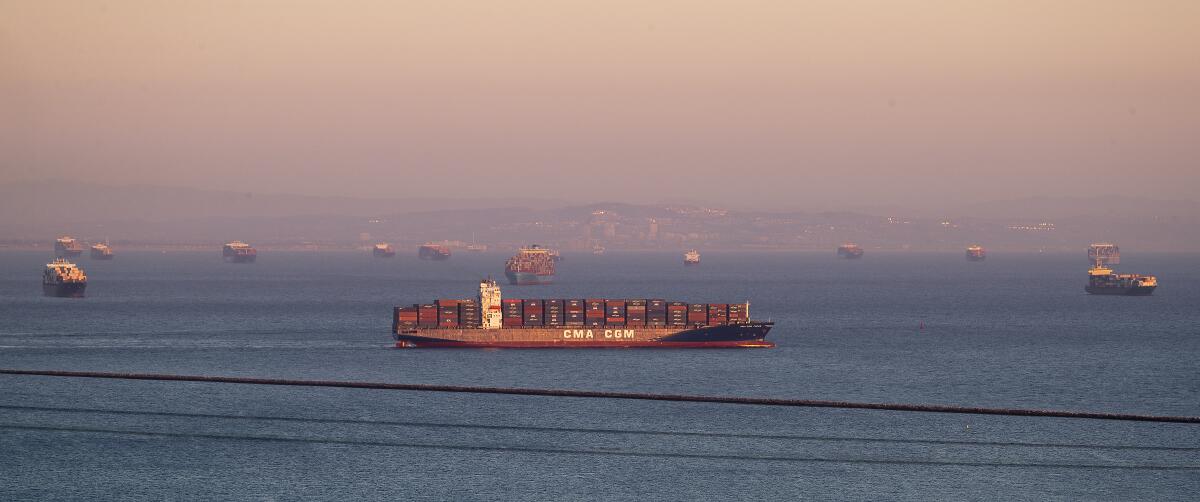Editorial: Supply chain issues affect almost everything, but surge in port pollution threatens our lungs

- Share via
Supply chain problems have caused a massive backlog of diesel-spewing cargo ships outside the ports of Los Angeles and Long Beach and disrupted the movement of goods across the nation. But the logjam has also brought an explosion in health-damaging air pollution.
The California Air Resources Board estimates that ships alone are pumping an additional 20 tons of smog-forming nitrogen oxides into the air each day — the equivalent of adding 5.8 million passenger cars to the region — while adding as much lung-damaging diesel particulate matter as nearly 100,000 big rig trucks. Monitoring data also show that black carbon, an indicator of diesel exhaust, has increased in the port area.
That’s bad news for harbor-area communities like Wilmington and West Long Beach that already suffer the region’s highest cancer risk from air pollution. Communities far from the ports are feeling it too. The greatest impacts have been in Inland Empire communities such as Mira Loma, which according to air quality officials have seen levels of fine particulate matter worsen with the influx of ship pollution. A state analysis earlier this year estimated that 20 premature deaths from cardiovascular disease could be attributed to increased pollution from ships idling off the coast.
Despite that, L.A. and Long Beach leaders still show no urgency to cut port pollution.
The foot dragging has gone on far too long, and it is time for regulators to step in to protect public health. The ports are the region’s largest single source of pollution. Yet leaders at the South Coast Air Quality Management District have spent years negotiating voluntary agreements with the ports to get them to commit to reducing their emissions, to no avail. They should end that process and finally do their job: Impose regulations to force the ports to clean up.
Southern California is still the nation’s smoggiest region and cannot clean its air to federal health standards without dramatic pollution cuts at the ports.
In 2017, Los Angeles Mayor Eric Garcetti and Long Beach Mayor Robert Garcia pledged to transform the publicly owned port complex into a largely zero-emission operation by 2035. But they have done little since then to cut emissions in the near term, even as air quality improvements at the complex have tapered off and smog has worsened to its highest levels in decades.
In March 2020, the ports agreed to set a fee of $20 per shipping container to raise funds to help truckers switch to zero-emission and methane-gas-fueled models. Not only is the fee too low to meet smog and greenhouse gas reduction targets, but the ports delayed it from taking effect, even as a pandemic-fueled buying surge and e-commerce boom pushed record volumes of cargo through the complex. The ports won’t start collecting the fee until next spring.
Tackling port pollution is complicated by the fact that most of it is generated by ships, trucks, locomotives and other mobile pollution sources that local air quality officials do not directly regulate.
But there’s a way around that. For well over a decade the South Coast AQMD has talked about using its authority under state law to regulate the ports as indirect sources of pollution, but hasn’t followed through. The ports, and key members on the air district’s governing board, have opposed regulation. So instead the district has spent the last few years in closed-door negotiations with the ports to try to get them to sign a voluntary agreement to clean their pollution.
In August, the air district board voted to give the ports a few more months to reach an agreement before pivoting to rule-making mode. That time is soon running out, with no sign of a breakthrough, especially with the Port of Los Angeles.
Port leaders, and the politicians who appoint them, have long gauged their success by the number of shipping containers moved. Perhaps if they were forced to measure progress by the number of bad air days, cancer cases or asthma attacks prevented, there would be more urgency to transform their operations.
Freight pollution is a major, ongoing threat to public health, air quality and the climate, and we cannot settle for half-measures and hope they make a dent. We need regulations with strict and enforceable timelines, targets and penalties that will ensure health-damaging emissions ratchet down steadily in the coming years until they reach zero.
The failure to swiftly clean the air does ongoing damage to the health of millions of people in Southern California, including children whose developing lungs are stunted by pollution. They cannot wait any longer for clean air and its health benefits.
Fortunately, regulators have a model. In May, the South Coast air board adopted a similar rule on indirect pollution that requires thousands of warehouse distribution centers to reduce emissions from trucks and other equipment associated with their operations. If the private sector can be required to reduce its pollution, surely the publicly owned ports, and their leaders, who so often voice their commitments to climate action and environmental justice, can be held accountable for their pledges too.
More to Read
A cure for the common opinion
Get thought-provoking perspectives with our weekly newsletter.
You may occasionally receive promotional content from the Los Angeles Times.










